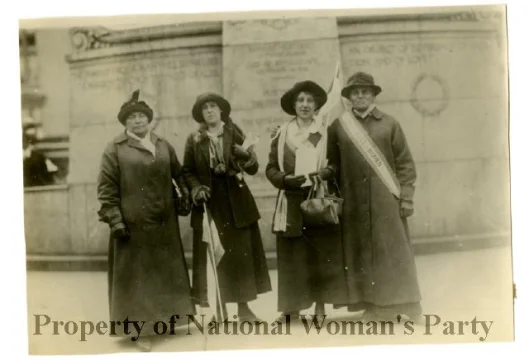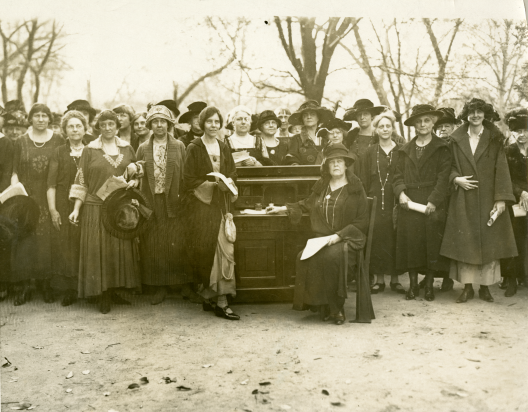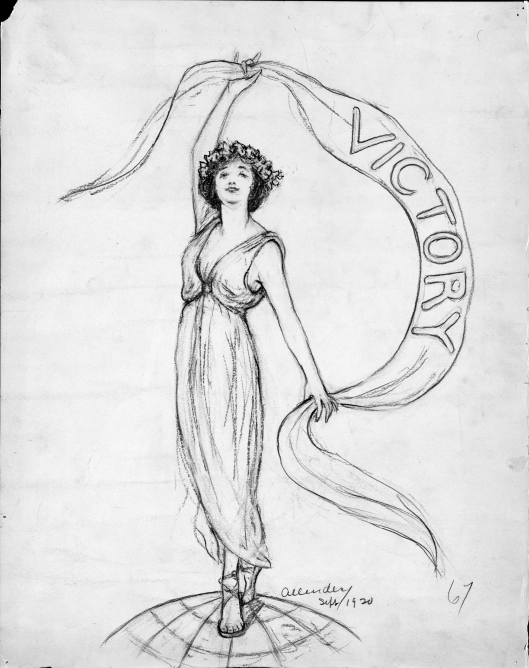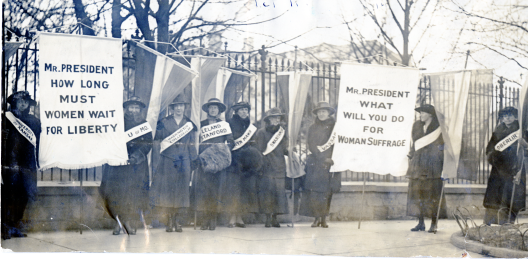I was roused from the torpor of this year’s endless existential crisis to imprecate the television screen when we watched The Vote, PBS’s two-part series on how the women’s suffrage movement. In the past nine months, I’ve given myself a crash course in women’s suffrage in order to intelligently perform at my contract position with the National Woman’s Party in Washington, D. C. As their Collections Manager, I can’t catalog, track provenance, and arrange unprocessed materials without knowing what you’re looking at. I’ve also provided researchers and documentarians with hundreds of images, including dozens used in The Vote. As a result, I was really anxious to see the film.
After viewing it, I thought a bibliography could be helpful for those interested in exploring topics and context in greater detail. The women’s suffrage movement and the passage of the 19th Amendment a century ago may seem unimportant compared to everything happening now, but knowing more about that movement can help us understand some of the divisions we see today.
A Brief Bibliography
I was able to get all of these from my local library system or using their ILL services.
Bausum, Ann. With Courage and Cloth: Winning the Fight for a Woman’s Right to Vote. Washington, DC: National Geographic, 2004.
Belmont, Alva E. (Mrs. Oliver H. P. Belmont ). “Woman’s Right to Govern Herself.” The North American Review, Vol. 190, No. 648 (November, 1909), pp. 664-674 University of Northern Iowa Stable URL: https://www.jstor.org/stable/25106503
Cahill, Bernadette. Alice Paul, the National Woman’s Party and the Vote: The First Civil Rights Struggle of the 20th Century. Jefferson: McFarland & Company, Inc., Publishers, 2005.
Cassidy, Tina. Mr. President, how long must we wait? Alice Paul, Woodrow Wilson, and the Fight for the Right to Vote. New York: 37 Ink/Atria, 2019.
Dumenil, Lynn. The Second Line of Defense: American Women and World War I. Chapel Hill: University of North Carolina Press, 2020.
Graham, Sally Hunter (1983). “Woodrow Wilson, Alice Paul, and the Woman Suffrage Movement.” Political Science Quarterly. 98 (4): 665–679.
Johnson, Joan. Funding Feminism: Monied Women, Philanthropy and the Women’s Movement, 1870–1967. Chapel Hill: University of North Carolina Press, 2017.
Lindsey, Treva B. Colored No More: Reinventing Black Womanhood in Washington, D.C. University of Illinois Press. (2017) Chapter Title: “Performing and Politicizing “Ladyhood”: Black Washington Women and New Negro Suffrage Activism.” https://www.jstor.org/stable/10.5406/j.ctt1p6qq7h.7
Roberts, Rebecca Boggs. Suffragists in Washington, D.C.: the 1913 Parade and the Fight for the Vote. Charleston, SC: History Press, 2017.
Walton, Mary. A Woman’s Crusade: Alice Paul and the Battle for the Ballot. New York: Palgrave Macmillan, 2010.
Weiss, Elaine. The Woman’s Hour: The Great Fight to Win the Vote. New York: Penguin Publishing Group, 1918. (available as an ebook)
Zahniser, J. D. and Amelia R. Fry. Alice Paul: Claiming Power. New York: Oxford University Press, 2014 (available as an ebook)
Online exhibits:
Library of Congress: Shall Not Be Denied: Women Fight for the Vote
National Archives: Rightfully Hers: American Women and the Vote
National Portrait Gallery: Votes for Women: A Portrait of Persistence
Online Resouces:
Library of Congress: Women’s Suffrage Teacher’s Guide
Additional Library of Congress resources, including another bibliography
PBS/Ken Burns on Women’s Suffrage

Women Voters Envoys, December, 1915. Envoys, left to right: Miss Kindberg, Sara Bard Field, Mabel Vernon, and Miss Kindstedt. NWP Collection, 1915.001.228.02
Some things left out are minor. Still, the two Swedish women who drove the American women from the San Francisco Exposition to Washington in 1915 collecting signatures in support of women’s suffrage had names: Maria Kindberg and Ingeborg Kindstedt. Marie owned and drove the car; Ingeborg was the mechanic.

Alice Paul (left) and Alva E. Belmont (right, seated) with members of the National Woman’s Party, around the desk that belonged to Susan B. Anthony. NWP Collection, 1920.001.107
Alva Belmont was active in the suffrage movement and funded much of the work of the National Woman’s Party, eventually going the party over $76,000. Belmont, whose first husband was William Vanderbilt, hosted Suffrage Teas at Marble House in Newport, RI. The iconic “Votes for Women” china? That was Alva’s. The NWP would not have been able to function without funding, and Alva (along with other wealthy women) was there to provide it.

Victory. Published on the front cover of The Suffragist, September 1, 1920. Charcoal drawing by Nina Allender. NWP Collection, 1920.003.008
In addition to donations, funding came from subscriptions to The Suffragist. The weekly newspaper was written, edited, and published first by the Congressional Union of NAWSA and then by the NWP. The covers frequently featured drawings and cartoons by Nina Allender, perhaps the most famous suffrage cartoonist.




I watched this show as well. It was great, and all I keep thinking is the statement:
They said they gave us the vote, we know we took it” no doubt badly paraphrased, but I love the sentiment.
I think you’ve gotten pretty close to what was said, actually. And the sentiment is 100% true! I’m glad you have enjoyed the program, it is a true privilege to work with the collections that document the fight for suffrage.